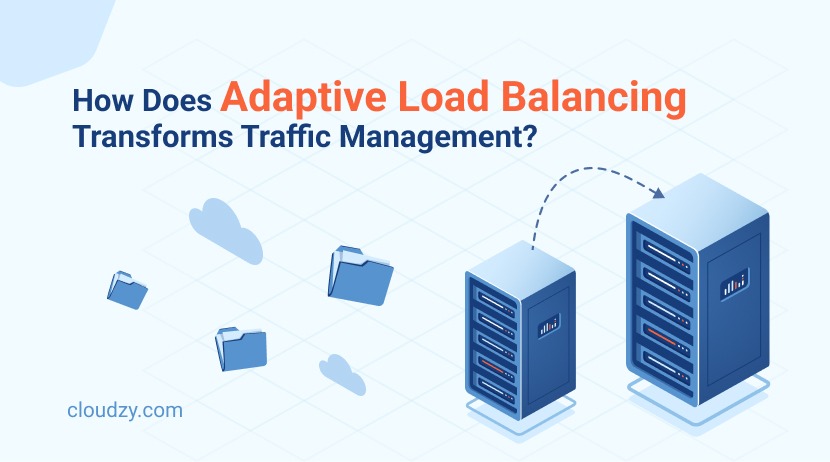Our digital age needs a rapid and smooth flow of information. This demand for speed and uninterrupted online services is important for the efficiency and performance of network systems. Adaptive load balancing is a game-changing solution that can address the speed challenge by distributing network traffic across servers. It also makes sure that its activity adapts in real time to changes in load, traffic type, and other critical factors. In this blog post, we will delve into what adaptive load balancing is, explore its key features and benefits, and demonstrate why it is becoming a necessary tool for businesses and network administrators.
Understanding Adaptive Load Balancing
Adaptive load balancing (Also known as dynamic load balancing) is a complicated technology that can enhance the distribution of data across a network. To understand adaptive load balancing, you first need to know the basics of load balancing technology. Now, let’s see what makes adaptive load balancing stand out, and how does it function at its core?
The entire reason behind using load balancing is that we want to resolve any traffic imbalance among servers. So, you can say the first task of any load balancing method should be finding a node that is bearing the lowest traffic. This node should also be highly responsive and available. The next important task of our load-balancing method should be detecting failed nodes. If a node fails to operate, the load balancing method should isolate it by removing it from the list of possible options. It should also be able to consider the node as an available option as soon as the node recovers.
Adaptive load balancing can consider all of these situations and analyze the state of the network. It evaluates factors such as server utilization, response times, and current traffic volumes and then makes real-time adjustments to traffic distribution. The ability to make real-time adjustments is exactly why we call it adaptive load balancing.
This adaptive process involves several key components:
- Traffic Monitoring: Adaptive load balancing algorithms continuously observe the incoming and outgoing traffic. This way, they can determine traffic distribution across servers.
- Performance Assessment: These algorithms also evaluate each server’s performance in real-time, including its capacity, current load, and response time to requests.
- Dynamic Adjustment: Adaptive laid balancing redistributes traffic based on the assessment data. This can ensure that servers have a balanced workload and that network performance is optimal.
- Failover Support: Adaptive laid balancing can reroute traffic away from failed or underperforming servers to maintain service continuity.
If you want to learn more about the mechanism of load balancing and how its algorithms work, I recommend our other blog on load balancing algorithms where we cover everything you need to know with details and examples.

The Importance of Adaptive Load Balancing
If you have any experience with web or application servers, you definitely know that the volume and velocity of data traffic can fluctuate dramatically. This fluctuation calls for an effective load-balancing method. Adaptive load balancing can be a critical aspect in making sure that despite this fluctuation, operation, and reliability remain stable. Next we’ll discuss how adaptive load balancing can help with modern network infrastructures.
Managing Unpredictable Traffic Patterns with Dynamic Load Balancing
A very basic challenge in network management is dealing with unpredictable traffic patterns. Lots of unexpected situations can result in huge spikes in web traffic. Seasonal trends, marketing campaigns, or sudden viral content are some of these common situations. Adaptive load balancing is great in these scenarios. Because it dynamically adjusts the distribution of network traffic to prevent any one server from becoming a bottleneck.
How Does Adaptive Load Balancing Enhance User Experience?
The speed and responsiveness of a website or application have a great influence on user satisfaction. Adaptive load balancing helps maintain optimal response times by promising that no single server is overwhelmed with requests. This brings faster load times and a smoother user experience. This enhanced user experience is crucial for retaining users and maintaining a competitive edge.
Improving Network Resilience with Adaptive Load Balancing
First let’s discuss what network resilience is. Imagine your server is facing lots of faults and challenges. This scenario will definitely affect normal operations and cause lags and issues. Network resilience is the ability to reduce these lags and issues and maintain an acceptable level of service when the server is having challenges. Adaptive load balancing can enhance network resilience by automatically rerouting traffic away from failed servers.
How Does Dynamic Load Balancing Impact Cost Efficiency and Scalability?
Another notable benefit of adaptive load balancing is scalability. It’s natural for any dynamic business to go through different phases. And in each of these phases, your servers experience different loads of traffic. If your traffic increases, you need to upgrade your resources to compensate for the new demand. And if your traffic shrinks in size, you need to downgrade to avoid any unnecessary costs. Adaptive laid balancing is able to optimize the use of existing resources. This way, you can manage your costs and resources better.
If you want to learn more about the advantages of load balancing, I highly recommend our other blog on the advantages of load balancing for enterprises.
Adaptive Load Balancing in Action
Adaptive load balancing is more than just a theoretical solution. In this section, we want to explore the use cases of adaptive load balancing in real life.
E-commerce Platforms
A smooth user experience is by far the most important aspect of an E-commerce platform. A smooth and friendly website means users will be more satisfied with their online purchases, which results in more sales. However, maintaining a smooth user flow becomes a bit harder in some seasonal situations, like holidays or black Friday. Adaptive load balancing can guarantee that even in the most intense traffic spikes, the website remains responsive and available. This way, the heavy load won’t affect the users and their shopping experience.
Streaming Services
Just like E-commerce platforms, streaming services highly depend on adaptive load balancing to deliver high-quality media streaming to their users. Adaptive load balancers are able to minimize buffering and latency issues in streaming services. They achieve this by balancing the load across servers in different geographical locations. This approach to media servers results in subscriber satisfaction and reduces churn in a highly competitive market.
Online Gaming
online gaming platforms have lots of active users who demand low latency and fast response times. In this industry, adaptive load balancing ensures a smooth, lag-free gaming experience by efficiently distributing server loads. This way, online gaming platforms can retain players and sustain engagement in the competitive market of online gaming.
Financial Services
In the financial sector reliability and response time are very important to users. No one likes it when a simple transaction takes long minutes to process. Adaptive load balancing can help trading platforms, online banking services, and other financial applications in handling traffic spikes and deliver reliable services. This helps with the most important aspects of a financial service which are reputation and security.
Want a high-performance Cloud VPS? Get yours today and only pay for what you use with Cloudzy!
Get Started HereConclusion
In this blog post, we talked about adaptive load balancing and everything it brings to the table. If you go with the right load balancing approach, you can expect huge improvements in your Cloud environment. The combination of adaptive load balancing and a cloud solution that’s already responsive and functioning can be the most effective thing you bring to your business. And for this purpose, I encourage you to check out Cloudzy’s Cloud VPS. This service is offered with a cost-effective pay-as-you-go model that allows you to save money and avoid unnecessary costs. It also has 24/7 support, a 99.95% uptime guarantee, NVMe/SSD Storage, and AMD EPYC™ processors. So, if you want to alter your Cloud experience, don’t hesitate to check out our services.
FAQ
What is automatic load balancing?
Automatic load balancing is a technique that distributes network traffic across multiple servers to prevent any one server from becoming overwhelmed. This technique makes sure that requests are manageable and improves the overall performance and reliability of a service.
What is an example of dynamic load balancing?
An example of dynamic load balancing is a web application that adjusts its resource allocation in real-time. This adjustment is based on the available server nodes and the number of incoming user requests.




